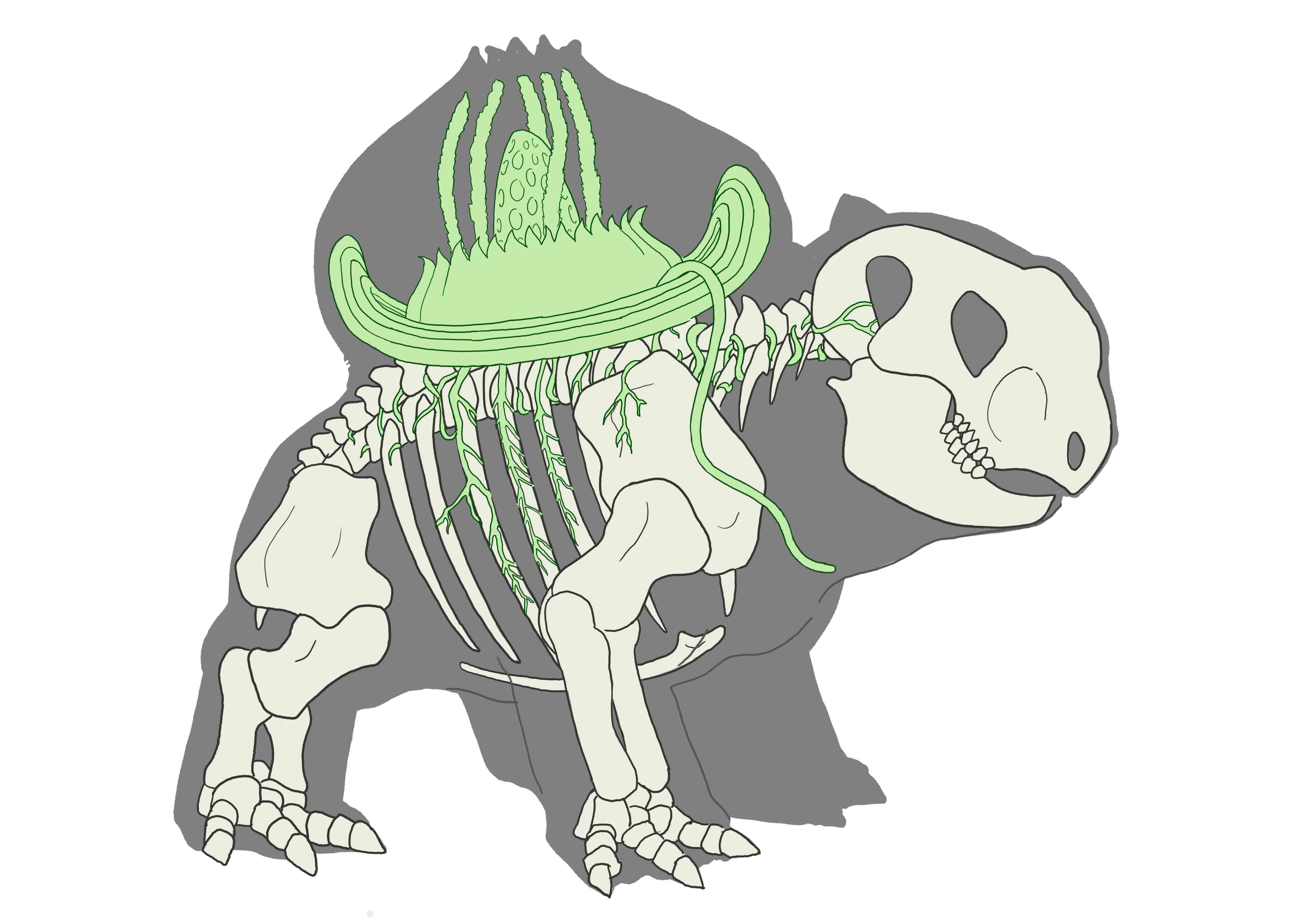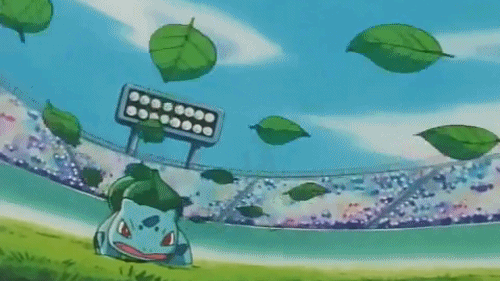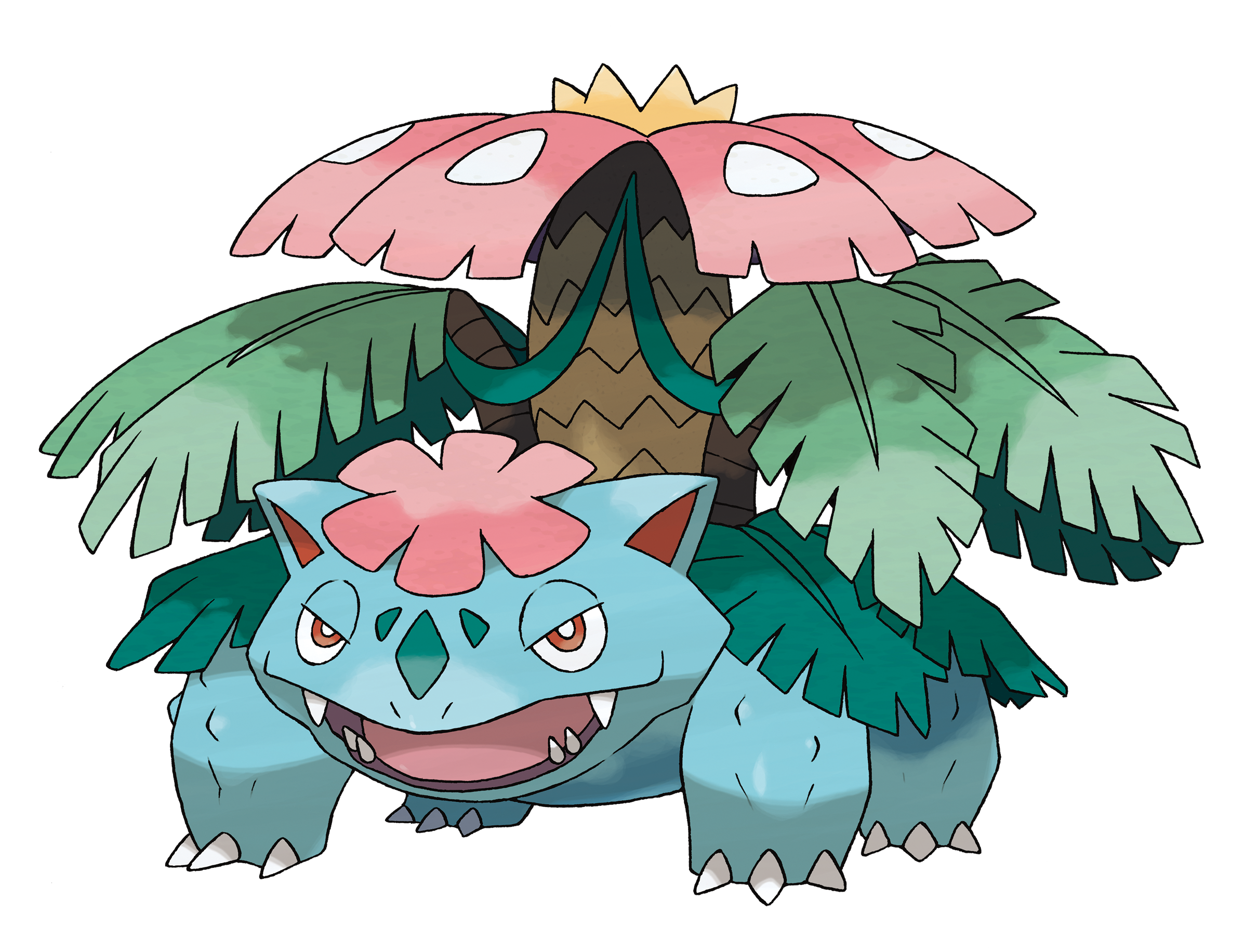Bulbasaur ~ Fushigidane (フシギダネ)
Ivysaur ~ Fushigisou (フシギソウ)
Venusaur ~ Fushigibana (フシギバナ)
Type[s]: Grass/Poison
Classification[s]: Seed Pokémon
Pokédex Number:
Average height:
Average weight:
Egg Group[s]: Grass, Monster
Abilities: Overgrow; Chlorophyll (hidden)
Bulbasaur, and its adolescent (Ivysaur) and adult (Venusaur) stages, comprise the first three Pokémon of the complete Pokédex: as well as the first Grass-Types, first Poison-Types, first starter Pokémon, and first evolutionary family.
Ivysaur ~ Fushigisou (フシギソウ)
Venusaur ~ Fushigibana (フシギバナ)
Type[s]: Grass/Poison
Classification[s]: Seed Pokémon
Pokédex Number:
- #001 (Bulbasaur)
- #002 (Ivysaur)
- #oo3 (Venusaur)
Average height:
- 2'4" (0.71m) (Bulbasaur)
- 3'3" (0.99m) (Ivysaur)
- 6'7" (2.01m) (Venusaur)
Average weight:
- 15.2lbs (6.9kg) (Bulbasaur)
- 28.7lbs (13kg) (Ivysaur)
- 220.5lbs (100kg) (Venusaur)
Egg Group[s]: Grass, Monster
Abilities: Overgrow; Chlorophyll (hidden)
Bulbasaur, and its adolescent (Ivysaur) and adult (Venusaur) stages, comprise the first three Pokémon of the complete Pokédex: as well as the first Grass-Types, first Poison-Types, first starter Pokémon, and first evolutionary family.
The Bulbasaur family is rare in the wild; though, due to its status as a starter Pokémon, they are quite common in captivity. Bulbasaur's natural habitat is generally open grasslands, though as juveniles they may inhabit woodlands; though they are threatened by human encroachment and destruction of habitat.
Similar to synapsids morphologically, Bulbasaur has features both reptilian and mammalian in its anatomy. However, as with many Pokémon, Bulbasaur are born pseudo-vivaparously: that is, are gestated inside of the pregnant mother, but are enveloped and laid as an egg late in development. In Bulbasaur's case, nutrient-rich seeds are produced by the plant on a pregnant female Venusaur's back, and attach symbiotically to developing Bulbasaur fetuses (Bulbasaur embryos are oriented in a Venusaur mother's uterus in such a way that the seeds nearly always attach themselves to the developing fetus' vertebral column; however defects in this very delicate process can lead to stillbirths, in which the seed attaches improperly; defects are virtually guaranteed in multiple births, and hence instances of healthy twin Bulbasaur are all but nonexistent).
Like most other Pokémon, Bulbasaur generally reproduce asexually, through a form of romantic haplodiploidic parthenogenesis: wherein biological gender is determined by the development either of an unfertilized haploid gamete (which results in a male embryo), or the fertilization of a diploid zygote via the union of a pair of haploids (which results in a female embryo). Unlike sexual reproduction, it is a form of romantic reproduction: wherein the process of procreation is originated solely in the mother, when she is subjected to sufficient romantic pheromones (similar, but distinct, to sex pheromones) from her chosen mate (though the mate, and thus its pheromones, must be male in order for conception to occur in the female), as well as heightened levels of oxytocin in her own brain (associated with romantic love for the mate). Because of this, Bulbasaur are monogamous, and mate for life. In Bulbasaur, it is far more common for offspring to be conceived from unfertilized gametes, and thus approximately 87.5% of Bulbasaur progeny are haploid, and become males, while only 12.5% are diploid, and become females.
As with most other Pokémon, Bulbasaur in the wild almost always breed with mates of their own kind; whereas in captivity, they are known to form mating bonds and reproduce with other species of Pokémon of compatible love pheromones (i.e., Pokémon within the same Egg Group).
Bulbasaur possess very solid and robust bones, which grow increasingly sturdy throughout their life cycle (as it matures and evolves into Ivysaur and Venusaur, its skeleton is gradually strengthened by xylem, cellulose, and lignin contributed from the plant on its back). During early development, the roots of the plant on a Bulbasaur's back spread and conjoin themselves densely through the vertebrae and ribcage, and make connections with the Bulbasaur's brain (allowing the Bulbasaur to send and receive neural signals to and from the plant, and thus have a degree of control and symbiosis with it). Due to the plant's roots intertwined with its skeletal and muscular systems, Bulbasaur have relatively limited and slow movement, especially in the spinal region; however, as Bulbasaur and Ivysaur, they are capable of moving rather quickly, due to their robust leg muscles (though their spines and skulls remain comparatively stationary).
Similar to synapsids morphologically, Bulbasaur has features both reptilian and mammalian in its anatomy. However, as with many Pokémon, Bulbasaur are born pseudo-vivaparously: that is, are gestated inside of the pregnant mother, but are enveloped and laid as an egg late in development. In Bulbasaur's case, nutrient-rich seeds are produced by the plant on a pregnant female Venusaur's back, and attach symbiotically to developing Bulbasaur fetuses (Bulbasaur embryos are oriented in a Venusaur mother's uterus in such a way that the seeds nearly always attach themselves to the developing fetus' vertebral column; however defects in this very delicate process can lead to stillbirths, in which the seed attaches improperly; defects are virtually guaranteed in multiple births, and hence instances of healthy twin Bulbasaur are all but nonexistent).
Like most other Pokémon, Bulbasaur generally reproduce asexually, through a form of romantic haplodiploidic parthenogenesis: wherein biological gender is determined by the development either of an unfertilized haploid gamete (which results in a male embryo), or the fertilization of a diploid zygote via the union of a pair of haploids (which results in a female embryo). Unlike sexual reproduction, it is a form of romantic reproduction: wherein the process of procreation is originated solely in the mother, when she is subjected to sufficient romantic pheromones (similar, but distinct, to sex pheromones) from her chosen mate (though the mate, and thus its pheromones, must be male in order for conception to occur in the female), as well as heightened levels of oxytocin in her own brain (associated with romantic love for the mate). Because of this, Bulbasaur are monogamous, and mate for life. In Bulbasaur, it is far more common for offspring to be conceived from unfertilized gametes, and thus approximately 87.5% of Bulbasaur progeny are haploid, and become males, while only 12.5% are diploid, and become females.
As with most other Pokémon, Bulbasaur in the wild almost always breed with mates of their own kind; whereas in captivity, they are known to form mating bonds and reproduce with other species of Pokémon of compatible love pheromones (i.e., Pokémon within the same Egg Group).
 |
| Copyright Ⓒ Joshua Dunlop |
Bulbasaur possess very solid and robust bones, which grow increasingly sturdy throughout their life cycle (as it matures and evolves into Ivysaur and Venusaur, its skeleton is gradually strengthened by xylem, cellulose, and lignin contributed from the plant on its back). During early development, the roots of the plant on a Bulbasaur's back spread and conjoin themselves densely through the vertebrae and ribcage, and make connections with the Bulbasaur's brain (allowing the Bulbasaur to send and receive neural signals to and from the plant, and thus have a degree of control and symbiosis with it). Due to the plant's roots intertwined with its skeletal and muscular systems, Bulbasaur have relatively limited and slow movement, especially in the spinal region; however, as Bulbasaur and Ivysaur, they are capable of moving rather quickly, due to their robust leg muscles (though their spines and skulls remain comparatively stationary).
Bulbasaur, being the youngest and weakest stage of it's life cycle, does not generally choose to hunt, or to forage: instead, it may disguise itself as a plant (either by hiding in foliage, or grass, or burying its body up to its bulb in mud or earth), and acquires energy via photosynthesis, and from the nutrient-rich seeds in its bulb. Bulbasaur may also rear up on its hind legs for brief periods, to see over the tall grass which is typical of its habitat (though it gradually loses this ability as it matures and evolves, as its legs and skeletal structure adapt to the weight of the growing plant on its back).
Due to its limitation in the movement of its spine, Bulbasaur and its mature forms are generally incapacitated if they are so unlucky as to be turned over on their side. However, they may be capable of using the vines of the plant on their back (which they can control at will, like tentacular appendages) to correct their position and turn themselves upright again. It is thought by some that the difficulty of being caught on their sides was a reason which led to the evolution of Bulbasaur's ability to manipulate its plant's vines. Though its vines are generally retracted inside its body (and coiled around the interior base of the plant), Bulbasaur is capable of lashing out with its vines at considerable speed. In general purpose, Bulbasaur's vines are among its primary defenses: it is famous for its Vine Whip, in which it can lash its vines like whips, as a weapon. Bulbasaur also possesses a layer of rigid-edged, razor-sharp leaves which grow rapidly beneath its primary layer of leaves: these can be detached at will via specialized muscle movements, and launched as projectiles, with impressive speed and accuracy. This Razor Leaf technique is the more violent and aggressive of Bulbasaur's defenses; Ivysaur favor it as a hunting method. Petal Dance is a move which operates under a similar principle, though it is only certain Bulbasaur which possess the specialized layer of petals needed to perform the technique.
Any given Bulbasaur has a finite number of its specialized razor leaves and/or petals at any one time, and so it has a certain "ammunition", which can be expended through overuse; however, they will grow back very quickly.

Though partially photosynthetic, Bulbasaur remains predominantly herbivorous throughout its life cycle; though Ivysaur may be partly omnivorous. Bulbasaur and its mature stages possess powerful jaw muscles, and thick mandibles; they have very few teeth however, having only premolars, and a beak (somewhat chelonian in external morphology). Though absent in juveniles, Ivysaur and Venusaur develop tusks in their upper jaw, similar to dicynodonts (though only a small portion of the tusks are visible when the mouth is closed). These tusks are present in both genders, and are generally used for confronting predators or adversaries (and, in Ivysaur's case, occasionally hunting). The diet of the Bulbasaur family generally consists of grasses, herbs, flowers, leafy greens, and some fruits and berries; they may also eat worms or insects, and Ivysaur may hunt or scavenge carrion from small animals or Pokémon, such as Rattata or Oddish. Upon evolution into its adult stage, the plant on its back adapts to become partially carnivorous: in order to supply additional energy to Venusaur, it attracts, digests, and metabolizes insects and Bug-Type Pokémon with a cocktail of fragrant aromas.
Ivysaur begins to produce a fragrant nectar in its bulb as it matures; the aroma generally increases in intensity leading up to its evolution into Venusaur, when the production of nectar is generally reserved for mating season, and serves as a signal to potential mates. Female Venusaur possess a large seed pod in their flower, which produces the seeds that will be implanted into embryonic Bulbasaur in utero.
Though it is born with only partially-developed ears, lacking an open pinna, as it matures and evolves into Ivysaur, the pinna develops into a full external ear; as Venusaur, it has a strong sense of hearing. Bulbasaur possesses a thick skin, which varies in hue from bluish to bluish-green (and usually becomes more bluish as it matures), spotted with irregular patches of darker pigmentation; upon evolution into Venusaur however, the pigmentation becomes saturated and blends with the general coloration of its skin, and its skin becomes thicker, and gains callosity, and bony synapsid-like osteoderms reinforced with cellulose fibers.
In the wild, Bulbasaur generally live to be around 50 years of age, however in captivity they may live up to twice their average wild lifespan. In the wild, Bulbasaur mature through their levels at a rate of on-average three levels per year, generally evolving into Ivysaur starting at Lv.16 (usually at around five or six years of age), and evolving again into Venusaur beginning at Lv.32 (usually at around ten years of age). In captivity however, as with most Pokémon, it is common for human interaction and Pokémon battling to cause their maturation process to accelerate, reaching its evolution levels and maturity in a matter of only months or years (or, in the care of a skilled trainer, a matter of weeks).

Capable of Mega Evolution, Venusaur can be artificially induced to temporarily evolve into a form further developed than its mature state. This does not occur in the wild, and is possible only by exposure of Venusaur to Venusaurite (Fushigibanite, フシギバナイト), an artificial crystalline substance that induces Mega Evolution in Venusaur when charged with energy from a corresponding Key Stone. Venusaurite is made from a similar material to Evolutionary Stones, Reveal Glass, and other evolution-inducing substances. When Mega Evolved, Venusaur becomes Mega Venusaur, and acquires power at the limits of its species. The plant on its back grows into an overdeveloped treelike state, granting Mega Venusaur a hugely increased supply of energy compared to its ordinary form. The additional energy thickens the hide and osteoderms of the Pokémon, and provides it with a layer of fat: these adaptations combined provide Mega Venusaur with greatly increased resistance to heat and cold, allowing it to withstand even Fire- and Ice-Type attacks with far greater ease.
Bulbasaur and its mature stages are regarded as very loyal and obedient Pokémon, and will form strong emotional bonds with their trainers.
Though it is born with only partially-developed ears, lacking an open pinna, as it matures and evolves into Ivysaur, the pinna develops into a full external ear; as Venusaur, it has a strong sense of hearing. Bulbasaur possesses a thick skin, which varies in hue from bluish to bluish-green (and usually becomes more bluish as it matures), spotted with irregular patches of darker pigmentation; upon evolution into Venusaur however, the pigmentation becomes saturated and blends with the general coloration of its skin, and its skin becomes thicker, and gains callosity, and bony synapsid-like osteoderms reinforced with cellulose fibers.
In the wild, Bulbasaur generally live to be around 50 years of age, however in captivity they may live up to twice their average wild lifespan. In the wild, Bulbasaur mature through their levels at a rate of on-average three levels per year, generally evolving into Ivysaur starting at Lv.16 (usually at around five or six years of age), and evolving again into Venusaur beginning at Lv.32 (usually at around ten years of age). In captivity however, as with most Pokémon, it is common for human interaction and Pokémon battling to cause their maturation process to accelerate, reaching its evolution levels and maturity in a matter of only months or years (or, in the care of a skilled trainer, a matter of weeks).

Capable of Mega Evolution, Venusaur can be artificially induced to temporarily evolve into a form further developed than its mature state. This does not occur in the wild, and is possible only by exposure of Venusaur to Venusaurite (Fushigibanite, フシギバナイト), an artificial crystalline substance that induces Mega Evolution in Venusaur when charged with energy from a corresponding Key Stone. Venusaurite is made from a similar material to Evolutionary Stones, Reveal Glass, and other evolution-inducing substances. When Mega Evolved, Venusaur becomes Mega Venusaur, and acquires power at the limits of its species. The plant on its back grows into an overdeveloped treelike state, granting Mega Venusaur a hugely increased supply of energy compared to its ordinary form. The additional energy thickens the hide and osteoderms of the Pokémon, and provides it with a layer of fat: these adaptations combined provide Mega Venusaur with greatly increased resistance to heat and cold, allowing it to withstand even Fire- and Ice-Type attacks with far greater ease.
Bulbasaur and its mature stages are regarded as very loyal and obedient Pokémon, and will form strong emotional bonds with their trainers.




I'm still fascinated by your analysis... It's like Bulbasaur is a real animal combined with a real plant. =)
ReplyDeleteThank you! :) Glad you're interested!
DeleteI plan on getting around to doing analyses of every Pokémon, however long it takes.